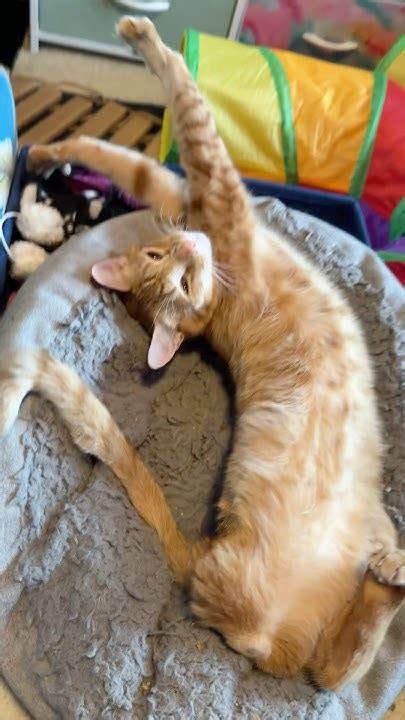
A diminutive rescue kitten, affectionately named Beans, has captivated the internet with a viral video showcasing its valiant, yet ultimately unsuccessful, battle against sleep following a tender “tuck-in” by its foster mother. The video, posted by Ashley Morrison of @youngestoldcatlady, has garnered millions of views, highlighting the kitten’s endearing struggle to stay awake and the nurturing care it receives.
The heartwarming video depicts Beans nestled in a cozy bed, eyes drooping heavily as Morrison gently adjusts the blanket around the tiny feline. Despite its best efforts to remain alert, Beans succumbs to slumber, providing viewers with an irresistible display of feline cuteness. This viral sensation has not only melted hearts but also drawn attention to the crucial work of animal rescues and foster caregivers.
Morrison, who has a history of fostering animals, especially those with special needs, has become a prominent voice in the animal rescue community. Through her social media platforms, she shares the daily lives of her foster animals, educating the public about responsible pet ownership and the importance of adoption. Beans’ story is a testament to the impact of dedicated care and the profound bonds that can form between humans and animals.
The overwhelming response to Beans’ video underscores the widespread appeal of animal-related content and the emotional connection people feel towards vulnerable creatures. The video’s virality serves as a reminder of the power of social media to raise awareness and promote positive change in the realm of animal welfare.
The Story Behind Beans
Beans’ journey began when the tiny kitten was taken in by Ashley Morrison, a seasoned foster caregiver known for her work with neonatal and special needs animals. Morrison’s home serves as a haven for vulnerable creatures, providing them with the necessary care and attention to thrive.
“I’ve been fostering for about six years,” Morrison explained. “I mostly take neonatal kittens, kittens who are less than eight weeks old, and kittens with special needs.”
When Beans arrived, the kitten was exceptionally small, even for a kitten of its age. Morrison noticed Beans’ need for specialized care, particularly ensuring the kitten was warm and well-fed.
The viral video captured a routine moment in Beans’ daily life – a gentle tuck-in before succumbing to sleep. Morrison regularly creates a comforting environment for her foster kittens, believing it’s essential for their well-being and development. The video’s authenticity and the genuine bond between Morrison and Beans resonated deeply with viewers, contributing to its widespread appeal.
The act of “tucking in” Beans involves carefully arranging the kitten in a comfortable position, often wrapping it in a soft blanket to mimic the warmth and security of its mother’s embrace. This simple gesture provides not only physical comfort but also emotional reassurance, helping Beans to feel safe and secure in its new environment.
Impact and Awareness
The viral success of Beans’ video has provided Morrison with a platform to advocate for animal rescue and responsible pet ownership. She uses her social media presence to educate the public about the importance of fostering, adoption, and supporting local shelters.
“It’s really important for people to understand the need for foster homes and the incredible work that rescue organizations do,” Morrison stated.
The video has also highlighted the challenges faced by neonatal kittens, who require intensive care and attention to survive. Without dedicated foster caregivers like Morrison, many of these vulnerable animals would not have a chance at life.
The response to Beans’ story has been overwhelmingly positive, with viewers expressing their admiration for Morrison’s dedication and their appreciation for the heartwarming content. Many have been inspired to consider fostering or adopting a pet, while others have chosen to support animal rescue organizations through donations or volunteer work.
The video’s reach extends beyond mere entertainment, serving as a catalyst for positive change in the animal welfare community. By showcasing the love and care provided to Beans, Morrison has demonstrated the profound impact that individuals can have on the lives of animals in need.
The Science of Kitten Sleep
The behavior exhibited by Beans in the viral video is not uncommon among kittens. Sleep is crucial for their development, playing a vital role in their physical and cognitive growth.
According to veterinary experts, kittens sleep for an average of 18-20 hours per day. This extended sleep time is necessary for conserving energy and allowing their bodies to develop properly. During sleep, kittens release growth hormones and consolidate learning experiences, similar to human infants.
The irresistible urge to sleep, as demonstrated by Beans, is driven by several factors, including the rapid development of their brains and nervous systems. Kittens also have smaller energy reserves compared to adult cats, making frequent naps essential for maintaining their energy levels.
Additionally, the warmth and security of a comfortable environment can further promote sleep in kittens. The act of being “tucked in,” as practiced by Morrison, provides a sense of safety and comfort, triggering relaxation and promoting sleep.
The combination of physiological needs and environmental factors explains why Beans struggled to stay awake, ultimately succumbing to the irresistible allure of slumber.
Fostering and Adoption: Making a Difference
The story of Beans underscores the critical role of fostering and adoption in animal rescue. Foster caregivers provide temporary homes for animals in need, offering them a safe and nurturing environment until they can be adopted into permanent homes.
Fostering can be a rewarding experience, allowing individuals to make a tangible difference in the lives of animals. It also provides valuable socialization and training opportunities for animals, increasing their chances of successful adoption.
Adopting a pet from a shelter or rescue organization can save a life and provide a loving home for an animal in need. Adoption also helps to reduce the number of animals in shelters, freeing up resources for other vulnerable creatures.
Morrison encourages individuals to consider fostering or adopting a pet, emphasizing the profound impact that these actions can have on the lives of animals. She also stresses the importance of responsible pet ownership, which includes providing proper nutrition, veterinary care, and socialization.
By supporting animal rescue organizations and promoting responsible pet ownership, individuals can contribute to creating a more compassionate and caring world for animals.
Animal Rescue: A Community Effort
Animal rescue is a community effort, requiring the collaboration of individuals, organizations, and government agencies. Rescue organizations work tirelessly to rescue, rehabilitate, and rehome animals in need, often operating with limited resources.
These organizations rely on the support of volunteers, donors, and foster caregivers to carry out their mission. Volunteers assist with various tasks, such as cleaning kennels, feeding animals, and providing transportation. Donors provide financial support, which is essential for covering the costs of veterinary care, food, and shelter.
Foster caregivers play a crucial role in providing temporary homes for animals, offering them the love and attention they need to thrive. By working together, these individuals and organizations can make a significant impact on the lives of animals in need.
The story of Beans is a testament to the power of community collaboration in animal rescue. Without the dedication of Morrison, the support of rescue organizations, and the generosity of donors, Beans would not have had the opportunity to experience the love and care it receives today.
The Future for Beans
As Beans continues to grow and develop, Morrison will continue to provide the kitten with the necessary care and attention. Once Beans is old enough, it will be spayed or neutered and made available for adoption.
Morrison hopes that Beans’ story will inspire others to consider adopting a pet from a shelter or rescue organization. She believes that every animal deserves a loving home and that adoption can be a life-changing experience for both the animal and the adopter.
In the meantime, Beans will continue to captivate the internet with its adorable antics and heartwarming story. Its viral video serves as a reminder of the profound connection between humans and animals and the importance of compassion and care.
Expanding on Ashley Morrison’s Work
Ashley Morrison’s dedication extends beyond simply providing a temporary home. She actively documents and shares her experiences, offering insights into the specific needs of neonatal kittens and animals with disabilities. This transparency helps educate aspiring fosters and adopters, equipping them with the knowledge to provide adequate care. Her social media platforms aren’t just showcases of cuteness; they’re valuable resources for anyone interested in animal welfare. She often answers questions about bottle feeding, administering medication, and managing various health conditions common in rescued animals.
Morrison’s approach also includes a strong emphasis on advocating for the animals in her care. She carefully screens potential adopters to ensure a good match, prioritizing the animal’s long-term well-being. She provides adopters with ongoing support and guidance, helping them navigate any challenges that may arise. This commitment to responsible rehoming is crucial for ensuring that rescued animals find permanent, loving homes where they can thrive.
The viral video of Beans is just one example of Morrison’s effective use of social media to raise awareness about animal rescue. She regularly shares photos and videos of her foster animals, highlighting their unique personalities and needs. This content not only attracts attention but also helps to break down stereotypes and misconceptions about rescued animals. By showcasing the resilience and adaptability of these animals, Morrison encourages people to consider adopting pets with special needs.
Furthermore, Morrison collaborates with local rescue organizations to promote their adoption events and fundraising campaigns. She leverages her platform to amplify their message and reach a wider audience. This collaborative approach is essential for maximizing the impact of animal rescue efforts and ensuring that more animals receive the care they need.
The Broader Context of Animal Welfare
The story of Beans is heartwarming, but it also sheds light on the broader challenges facing animal welfare. Millions of animals enter shelters each year, many of whom are euthanized due to overcrowding and lack of resources. Addressing this issue requires a multi-faceted approach that includes promoting responsible pet ownership, increasing access to affordable veterinary care, and supporting animal rescue organizations.
Spaying and neutering are essential for preventing pet overpopulation and reducing the number of animals entering shelters. Low-cost spay/neuter programs can make these services more accessible to low-income pet owners. Educating the public about the importance of spaying and neutering is also crucial for changing attitudes and behaviors.
Access to affordable veterinary care is another critical factor in animal welfare. Many pet owners struggle to afford basic veterinary services, such as vaccinations and preventative care. This can lead to serious health problems for their pets and increase the likelihood of them being surrendered to shelters. Expanding access to affordable veterinary care can help keep pets healthy and in their homes.
Supporting animal rescue organizations is essential for providing care to animals in need. These organizations rely on donations, volunteers, and foster caregivers to carry out their mission. By supporting these organizations, individuals can help ensure that more animals receive the care they need.
Furthermore, advocating for stronger animal protection laws can help to prevent animal cruelty and neglect. Stricter laws and enforcement can deter animal abusers and ensure that they are held accountable for their actions. This can help to create a safer and more humane environment for animals.
The Power of Social Media for Animal Advocacy
Beans’ story demonstrates the immense power of social media in promoting animal advocacy. The viral video reached millions of people around the world, raising awareness about animal rescue and inspiring countless individuals to take action. Social media platforms provide a powerful tool for connecting with like-minded individuals, sharing information, and mobilizing support for animal welfare causes.
Animal rescue organizations can use social media to showcase their work, promote adoption events, and raise funds. They can also use social media to educate the public about responsible pet ownership and advocate for stronger animal protection laws. Individual animal advocates can use social media to share their stories, raise awareness about animal welfare issues, and inspire others to get involved.
The use of hashtags, such as #adoptdontshop, #rescuedog, and #animalrescue, can help to connect people with relevant content and increase the visibility of animal welfare campaigns. Social media challenges, such as the #ClearTheShelters challenge, can also be effective in raising awareness and promoting adoption.
However, it is important to use social media responsibly and ethically. Animal advocates should avoid sharing graphic or disturbing content that could traumatize viewers. They should also be careful to avoid spreading misinformation or promoting harmful stereotypes about animals.
By using social media strategically and responsibly, animal advocates can effectively raise awareness about animal welfare issues, mobilize support for their causes, and create a more compassionate world for animals.
Ethical Considerations in Animal Content
The popularity of animal content online raises important ethical considerations. While videos like Beans’ can be heartwarming and raise awareness, it’s crucial to ensure the animal’s well-being is always prioritized. Exploitation for views should be avoided.
Responsible content creation involves:
- Respecting the animal’s natural behavior: Avoid forcing animals into unnatural poses or situations for entertainment.
- Prioritizing their comfort and safety: Ensure the animal is not stressed or harmed during filming.
- Avoiding harmful trends: Refrain from participating in trends that could endanger animals.
- Educating viewers: Use the platform to share accurate information about animal care and welfare.
- Seeking expert advice: Consult with veterinarians or animal behaviorists to ensure ethical practices.
The line between harmless entertainment and exploitation can be blurry. Constant vigilance and a commitment to the animal’s best interests are essential for ethical animal content creation.
The Human-Animal Bond: A Deeper Look
The overwhelming response to Beans’ video highlights the profound human-animal bond. This connection is deeply rooted in human history and has evolved over millennia. Animals provide companionship, emotional support, and a sense of purpose for many people. Studies have shown that interacting with animals can lower blood pressure, reduce stress, and increase levels of endorphins.
The human-animal bond is mutually beneficial. Humans provide animals with food, shelter, and care, while animals offer unconditional love and companionship. This relationship can be particularly important for vulnerable populations, such as children, the elderly, and people with disabilities.
The bond between humans and animals is not limited to domesticated pets. Wildlife encounters can also evoke strong emotions and a sense of connection with nature. Protecting wildlife and their habitats is essential for maintaining the health of the planet and preserving the human-animal bond.
FAQ Section:
1. What is a neonatal kitten and why do they need special care?
Neonatal kittens are kittens less than eight weeks old. They require special care because they are completely dependent on humans or their mothers for survival. They cannot regulate their body temperature, need help with feeding, and are vulnerable to diseases. They also need to be stimulated to urinate and defecate. Without proper care, neonatal kittens have a very low survival rate. Ashley Morrison specializes in caring for these vulnerable kittens, providing them with the round-the-clock attention they need.
2. How can I become a foster caregiver for animals?
To become a foster caregiver, contact your local animal shelter or rescue organization. They will typically have an application process and may require a home visit to ensure that your home is a safe and suitable environment for foster animals. You will also need to be willing to provide the necessary care, including feeding, cleaning, and providing medical attention when needed. Many organizations will provide training and support for foster caregivers. Being a foster caregiver is a rewarding experience that makes a real difference in the lives of animals.
3. What are the benefits of adopting a pet from a shelter or rescue organization?
Adopting a pet from a shelter or rescue organization saves a life and helps to reduce the number of animals in shelters. Adopted animals are typically already spayed or neutered, vaccinated, and microchipped, which can save you money on veterinary costs. Adult animals often come with established personalities, making it easier to find a good fit for your lifestyle. Shelters and rescues often have a wide variety of animals, so you can find the perfect companion for your family.
4. How can I support animal rescue organizations if I can’t foster or adopt?
There are many ways to support animal rescue organizations even if you cannot foster or adopt. You can donate money to help cover the costs of veterinary care, food, and shelter. You can volunteer your time to help with tasks such as cleaning kennels, walking dogs, or assisting at adoption events. You can also donate supplies such as blankets, towels, and food. Spreading awareness about animal rescue on social media can also help to reach a wider audience and encourage others to get involved.
5. What are some ethical considerations when sharing animal-related content online?
When sharing animal-related content online, it is important to prioritize the animal’s well-being and avoid exploitation. Avoid forcing animals into unnatural poses or situations for entertainment. Ensure the animal is not stressed or harmed during filming. Refrain from participating in trends that could endanger animals. Use the platform to share accurate information about animal care and welfare. Consult with veterinarians or animal behaviorists to ensure ethical practices. Always consider the animal’s best interests before sharing content online.









